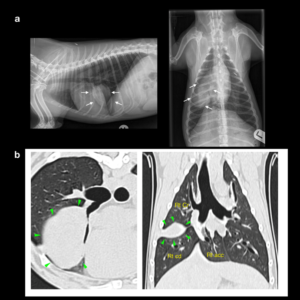Lung Tumours
In dog tumors that originate in the lung are rare (primary lung tumors). Metastatic lung cancers (secondary lung tumor-cancers that spread to the lungs from other locations) are much more common in dogs than primary lung cancers. However, the prevalence of primary lung cancers appears to be increasing in the last 15 years. This trend may be due to different reasons, including longer companion animal life expectancy and the development of more accurate diagnostic techniques. Most frequently the primary lung tumors are diagnosed at an average age of 9 to 12 years in dogs. All breeds and both sexes appear to be equally affected. Most primary lung tumours are malignant and tend to metastasize (spread) to the lungs, lymph nodes and bones, although spread to other organs may also occur.
Symptoms
Primary lung tumors have variable signs, which depend on the location of the tumor, rate of tumor growth, and the presence of previous or current lung disease. The most common signs in dogs include weight loss, depression, coughing and labored breathing. Other signs include reduced exercise tolerance, rapid breathing, poor appetite, vomiting or regurgitation, fever, and lameness. Some dogs will not show any clinical signs in the early phase of the disease.
Diagnosis
X-rays are usually the first way of assessing whether or not a dog has lung cancer. More information can be gained from Computed Tomograpy (CT) scans which give us much more detail which helps with treatment planning. The scans are very useful for detecting what part of the lung is affected and also whether or not any secondary tumours are present. These scans are usually performed under general anaesthesia. The final diagnosis ie what type of lung cancer can only be made after a biopsy is taken either before or during surgery.
Figure1. Chest x-rays, lung mass in right middle lung lobe (white arrows). CT scan, lung mass in right middle lung lobe (green arrowhead)
Treatment and outcome
Thoracic surgery to remove the portion of the lung containing the tumor is the recommended treatment in most cases.. Surgical patients usually stay hospitalised until they are judged to be free from pain and are usually discharged 1-2 days after surgery. Tumours that cannot be operated on or those that have spread may be treated with chemotherapy by our Internal Medicine services.
Importantly, the majority of dog owners report improved quality of life of their pets following surgery.
A dog with a single primary lung tumor that has no metastasis (spread) to the lymph nodes has the longest average survival time (an average of > 12 months); sadly if the lymph nodes are involved or multiple tumors are found at the time of diagnosis, survival time is much shorter (1-4 months). This difference in prognosis emphasises the importance of getting as much accurate preoperative information (eg CT scans) as possible.
All surgeries have an associated risk of complications and these will be discussed with you in detail during a consultation with one of our surgical team. The risk of complications will be mimimised when the surgery is performed by an experienced surgical specialist such as a member of our team here at Eastcott Referrals. Our surgery team also works very closely with our anaesthesia and intensive care teams to provide the best care possible for your pets.
Please contact us for details

